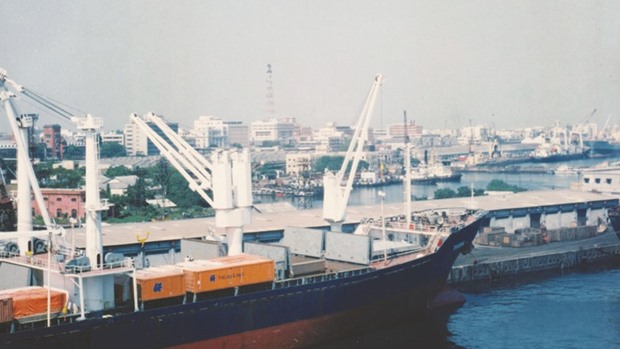Signalling a definitive reversal of the continuous decline in Indian exports through most of last year, official data yesterday showed these grew for the fourth month in a row at $23.89bn in December 2016, an uptick of an impressive 5.72% over the $22.59bn in December 2015.
The data released by the Commerce Ministry showed the increase of exports sequentially over the 2.29% growth in November, but was slower than the 9.59% growth in October.
Cumulatively for the April-December period, exports rose marginally by 0.75% in dollar terms at $198.8bn, as against exports of $197.3bn over the same period last year.
The government said exports declined to the US (-1.21%), China (-7.45%) and European Union (-6.27%). but these grew for Japan ((3.79%) during October 2016 over the corresponding period of the previous year, as per latest WTO statistics.
“Non-petroleum exports in December 2016 were valued at $21.12bn against $20.03bn in December 2015, an increase of 2.2%,” a statement said.
Imports during the month in question at $34.25bn, were 0.46% higher than the imports of $34.10bn in December 2015.
Consequently, the trade deficit in December was lower at $10.37bn, as compared to the deficit of $11.50bn during same month of 2015.
Cumulative imports for April-December 2016 were worth more than $275.4bn, which was a 7.42% fall from the over $297.4bn worth imports recorded for the same period of 2015.
With global oil prices climbing back to over $50 a barrel, India’s oil imports during December 2016 were valued at $7.65bn, which was a sharp 14.61% higher than oil imports valued at $6.67bn in the corresponding month of 2015.
Non-oil imports in December fell by 2.98% to $26.60bn, from $27.43bn in the same month of last year
The trade deficit cumulatively for April-December, however, declined to $76.55bn against $100bn in the same period of 2015-16.
As per Reserve Bank of India data yesterday, services exports during November 2016 were valued at $13.34bn, registering a marginal increase over the $13.11bn worth exported in October.
Taking merchandise and services together, overall trade deficit for April-December 2016 is estimated at $33.74bn, which is an impressive 36.78% fall in dollar terms than the level of $53.37bn during the same period last year.
Meanwhile, India’s petroleum consumption growth in the first nine months of the current fiscal has slowed to 5.4% as compared to 9.6% in fiscal 2015-16, a report said yesterday.
“Domestic petroleum consumption grew moderately by 5.4% in nine months of FY17 as compared to a robust 9.6% in FY2016, excluding petcoke volumes, led by moderation in growth of diesel, naphtha and bitumen,” Kotak Institutional Securities said in a report.
“Overall petroleum consumption growth was robust at 8.8% in nine months of FY17, albeit lower than 11.6% in FY2016, driven by 40% growth in petcoke and 11% growth in gasoline, LPG and ATF (aviation turbine fuel),” it said.
“Our analysis is corroborated by evident reduction in public sector undertakings’ (PSUs) share of domestic petroleum volumes over the past few years.”
Kotak said the country’s growth in demand for auto fuels moderated in the April-December period, with diesel demand growing by a modest 3.7% year-on-year, as compared to 7.5% growth in the last fiscal.
Gasoline, or petrol, demand during the period in consideration grew by 11.2% although it was lower than 14.5% growth in fiscal 2016, it added.
“Kerosene off-take declined sharply by 17% during April-December, as compared to a decline of 3.7% in the FY2016, impacted by a reduction in allocation under the public distribution system,” the report said.
According to Kotak, PSUs’ share of volumes has reduced, led by loss in market share of auto fuels and rising imports
“Growth in domestic sales volumes by oil marketers has fallen short of growth in domestic petroleum consumption over the past few years, driven by 2-3% loss of market share in auto fuels to private players since deregulation of diesel and substantial increase in imports of fuels such as petcoke by consuming industries directly or through trade channels,” it said.
Instead, petroleum coke demand remained strong, growing at a steep 40% over the same period last year, as compared to 33% growth in the whole of the previous fiscal “led by continued increase in off-take by cement plants and aluminium smelters”.
Petroleum coke imports have increased significantly since April 2014 as domestic production fell short of sharply rising demand, Kotak said.
“We note that OMCs (oil marketing companies) rarely import petroleum fuels to sell in domestic markets,” it said.
On the stocks of the state-run OMCs, Kotak said the Indian Oil Corp shares were being given preference over those of Bharat Petroleum Corp (BPCL) and Hindustan Petroleum Corp (HPCL).
“We continue to prefer IOC over BPCL and HPCL, given expected strength in underlying earnings driven by robust margins and improvement in contribution of Paradip refinery and relatively inexpensive valuations as compared to BPCL and HPCL,” it said.

As per Reserve Bank of India data yesterday, India’s services exports during November 2016 were valued at $13.34bn, registering a marginal increase over the $13.11bn worth exported in October.
